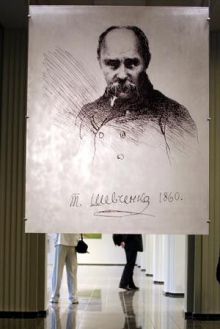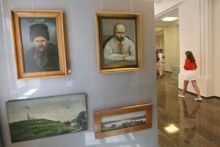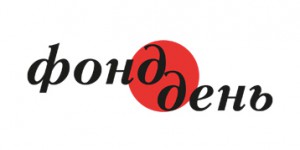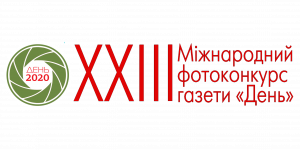Work on the restoration of Kaniv’s Taras Shevchenko Museum is over. The museum’s interior has been completely reconstructed according to architect Larysa Skoryk’s sketches, the museum’s facade has also been restored, and the area’s facilities have been improved. The overall cost of the reconstruction exceeded 96 million hryvnias. However, society has perceived the restored museum quite ambiguously, which is no surprise: the outstanding architect Vasyl Krychevsky’s paintings have been covered with plasterboards, the sculptures that used to stand in the museum have been packed in plastic bags and are hidden behind the new exposition. There are touchscreens showing what the building was like previously, as well as TV sets and a “sky” projected on the museum’s ceiling. Lying on the granite plates, one can look at the interactive clouds and read Kobzar on them. The museum also has numerous portraits of Shevchenko, where he is depicted in a sheepskin coat and an astrakhan hat, which completely contradicts the concept promoted by the present-day power — Shevchenko was a young dandy, let his museum be equipped in a high-tech style.
COMMENTARIES
Oles SANIN, a film director:
“Everything is very modern, very cool. There was too little time, and it must have been hard to do everything otherwise. But the museum produces an impression of a Google or Wikipedia website. You type ‘Taras Shevchenko,’ and see his portrait, illustrations, works. This is an interactive exposition. The museum which used to be here has moved to some other place. Some items have been left in houses and behind the walls. I have heard a fantastic quote from architect Larysa Skoryk, who said that Krychevsky, who built the museum, was not a free man, and everything was made on the orders of the Soviet power, therefore he could not do what he wanted. He dreamed that once a person would come, who would be eager to change everything. I don’t think that the architect of the Kheops pyramid dreamed that a person would come and change everything. But thinking of changes is a very typical for an architect. I guess Skoryk had an immense desire to change all the Soviet legacy, which she understandably does not like. And she has completed the task very well. She has taken away everything Soviet out of the museum. There is nothing left. I have heard the impressions of the museum employees who have worked here for 40 years. They had worshipped the place. Now they say that there is nothing left of it. Any museum has its unique style. I am sure that architect Larysa Skoryk tried to create it, but so far I have the impression that the museum’s exposition can be easily and completely changed by tomorrow. Wonderful walls, wonderful light, very nice floors. In a night the museum’s exposition can be changed and dedicated to another person. Besides, there is a smell of paint, and I don’t like this smell in museums. Even modern art museums, like the Metropolitan, have a smell of history. This museum lacks this smell. Several hours have passed since the president announced that a new exposition was launched, and it smells of statesmen. Hopefully this dust of time will emerge. Hopefully, Taras will peep in here and look at the exposition. Maybe in the night.”
Oleksandra SOLOPCHENKO, deputy director general of the Taras Shevchenko House-Museum:
“There are many things in this exposition that I like. Specifically, the usage of symbols. So, for instance, the stone from the Cherkasy deposit is in the museum’s center. It is a cornerstone, covered with blue silk. It symbolizes Shevchenko who is a cornerstone of our national structure, according to Ivan Dziuba. The museum should evoke the visitors’ interest in Shevchenko’s personality, influence their feelings, help them to come to the poet. But in my opinion, minimalism is unjustified. It is difficult to speak about Shevchenko with the help of a mere two-three items, albeit precious. Shevchenko’s time is not present here, nor are the editions that saw the light during his life, the creative work of his contemporaries. It is impossible to show how his literary talent took shape. There are also too few paintings executed by Shevchenko, though we know that his legacy as a painter largely exceeds the number of his poetic works. As for the revival of Shevchenko’s image as a ‘young dandy,’ the exposition does not reveal it. I think that this is not to Shevchenko’s merit. We all were young once, so was Shevchenko. He wanted to be a free man, to taste all of life’s temptations. So, paying the fashion its due, he dressed in a modern way. He had suits that differed from those of peasants. With time, as he matured, these likings passed. He remained a modern person, yet his ‘being a dandy’ is not a feature for which Shevchenko is known, and one should not put extra emphasis on it.”
Hanna HERMAN, deputy chief of the presidential staff:
“The reconstruction of Kaniv’s museum is the fulfilment of the president’s promise at Taras Shevchenko’s grave. The works are still going on. The hills, the park and the hotel allotted to the memorial will also be put in order. We are also doing a lot to bring back the authentic objects which belonged to Shevchenko from Russian collections, and to enrich the memorial. On the whole, the museum’s exposition is pure, it lacks original items, but there are lots of them throughout the world. I think that there are some things left in Kazakhstan, we will speak with our Kazakh fellows about this. I know that Medvedev and Yanukovych have discussed a joint celebration of Shevchenko’s 200th birth anniversary. This museum is one of the first attempts to speak about Shevchenko as a modern person, a man who loved Chopin, not just Ukrainian folk songs. We know Shevchenko as a man who has done much for Ukrainian folklore, we know that there are many folk songs in Shevchenko’s verses. But we forget that he was an elitist poet. One should not make an old man, in a sheepskin coat and sheepskin hat, of him. We know that he was a dandy, a golden youth representative, with whom many Petersburg ladies fell in love. This image of Shevchenko should be promoted and revealed for the youth. When I was asked today whether the president would come in an embroidered shirt, I replied, no, because Shevchenko is associated not only with embroidered shirts, but also with a tail coat and a bow tie. Shevchenko was a very stylish young man, so let’s see him from another angle. Let us promote the image of a young, modern, highly educated person, because we have had enough of the old man in a sheepskin coat and hat. The propaganda was doing this deliberately, so that we did not know any other Shevchenko. But Ukrainians are a stylish European nation and we should always keep in mind that Shevchenko was the first one among us in this regard.”
Zinaida TARAKHAN-BEREZA, scholarly associate at the Shevchenko National Preserve:
“The museum was Ukrainian. It was highly prized by Ukrainian and foreign experts even before the reconstruction. And now Skoryk has decided that it is a peripheral museum. ‘Krychevsky is neither an artist, nor an architect,’ she stated. I think that this kind of restoration is a crime against the nation. A lot of people came to Taras’ front room, and they felt so rejoiced. They said it was the only corner where they could come, and that it is good that Larysa Skoryk had not touched it. Black granite, a symbol of Eastern tyrannies, is laid on the floor of the museum. There is something inexpressive and grey in the place of the formerly beautiful stained-glass window. There was a barrier with ornaments restored based on Krychevsky’s project, it cost 2.5 million hryvnias. Now it is lying in our basement. Instead they have placed a glass barrier on the first floor. The only thing remaining are the paintings in the rosettes in the entrance hall. The national decoration of the museum has been completely ruined. This is a heavy blow to the Ukrainian culture. But an optimistically-minded. The people have expressed their opinions about the exposition and what kind of crime has been committed here. Perhaps God is testing us, hoping that we stand up for ourselves. Shevchenko did everything for his people to have this consciousness. All the people, as one, should tell the president and Larysa Skoryk that one should not do this to national culture monuments, because we are living in an independent Ukraine, and the people won’t allow the destruction of the national image of Shevchenko’s modernized house.”
Larysa SKORYK, architect:
“At the time when the museum was being constructed, the world was at the climax of avant-garde and Vasyl Krychevsky adorned the building in not quite a Ukrainian style, but in the style of Greek reminiscences greatly admired by Stalin. Krychevsky always had supervisors from the Central Committee and the party who told him what and how should be built. He made lots of sketches, but the principle of that time was that the museum should have been socialist in terms of content, and national in terms of shape. The form, as a rule, was revealed through ornaments and paintings. The poor man had to do lots of sketches to decorate the museum. They are so forced and squeezed out. He tried majolica, but refused, he tried painting, then Hutsul style. Yet this was a torment for him. At the time it was very difficult to do anything. But Krychevsky’s talent helped to build a proportional, elegant museum with large windows. We have brought back the character of a memorial. We have accommodated Shevchenko’s modern personality. I regret that the stereotype of Shevchenko wearing a sheepskin coat has been spread. In reality he was a young, energetic and beautiful man, he was a favourite of artistic salons. When Krychevsky’s grandson came to me and saw the result, he said, ‘My grandfather would probably do it the same way.’ Yes, the reaction to the museum varies. But I don’t pay attention to this nonsense. In my life, I have heard even worse comments. Tomenko and Yavorivsky grew concerned and called me to the Minister of Culture, who approved the reconstruction project. They asked him, ‘What are you doing there? Why not restore flowers?’ He replied that the money was embezzled for the past seven years, while the museum stood in ruins — you had seven years to do whatever you liked, and now you’re binding our hands.”
Oleksandra TELIZHENKO, the Merited Artist of Ukraine:
“I am happy that Krychevsky’s paintings, that were inside, have not been destroyed, just hidden. One may take them from the storeroom and restore them later. At the entrance there used to be the museum’s calling card. Do you remember what it was? Original stained-glass window. Now they have placed bars on everything. This is it. They have made a so-called hit. They have emasculated the soul, making a bland show that can be created in any city. They did not need to do it on Taras Hill. They have hidden the soul in the reserves. There is no exposition. There is a sort of a Western movement that can be done anywhere. Shevchenko is the soul — they have made a sort of an empty picture. But one should know and honor Shevchenko. For Larysa Skoryk it seems to be mentally unreachable.”








